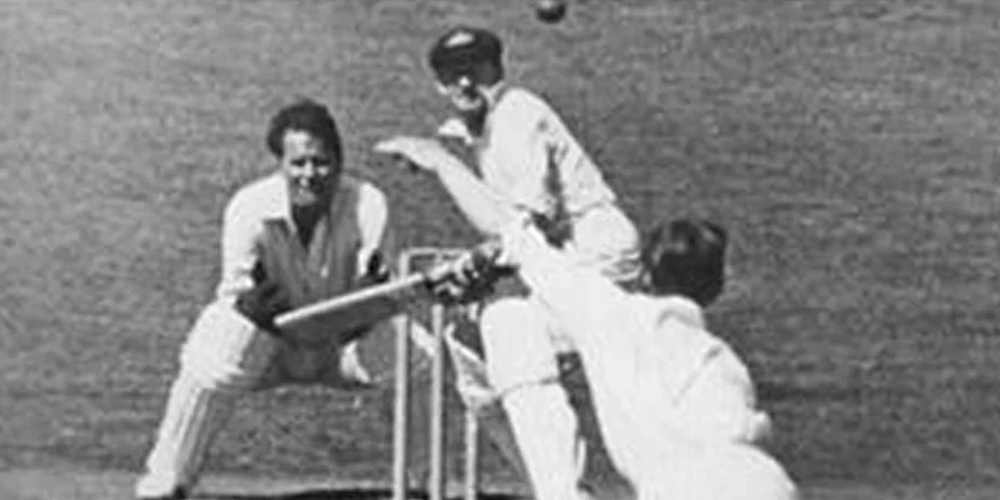
The all-conquering Australians, under the captaincy of Don Bradman, arrived at Southchurch Park in glorious weekend sunshine to entertain packed crowds. Scheduled for three days, such was the overwhelming superiority of the tourists that the match was completed in two, each day attracting an estimated 16,000 spectators.
The visitors had won five consecutive matches, four by an innings, before this fixture and the crowds flocked to the seaside venue just a stone’s throw from the seafront to witness the Australians making hay in the Southend sun after winning the toss.
By lunch, having set the tone for the banquet of big hitting and fast scoring, they had reached 202 for the loss of one wicket after openers Sid Barnes and Bill Brown had put on 145 in 95 minutes before being parted, the only moment of concern for the batsmen occurring when Brown’s off stump was removed early on but off a no-ball. They continued undaunted and unbridled until Barnes hit his wicket trying to cut off-spinner Ray Smith.
Next man in, Bradman maintained the momentum and he served the crowd with a splendid hors d’oeuvre immediately before lunch when, after blocking the first ball of the final over before the interval, he struck the next five deliveries from leg-spinner Frank Vigar to the mid-wicket boundary.
For 90 minutes, “The Don” and Brown struck out freely to gather a whirlwind 219 runs before Brown was caught off the bowling of Trevor Bailey. With the score 364-2, Aussie golden-boy of the time the charismatic Keith Miller was bowled first ball by Bailey when he shouldered arms. There was some debate as to why Miller surrendered his wicket. One school of thought suggested he changed out of his whites and went to the races whilst another suggestion was that he wanted to resume a game of poker in the pavilion. A third line of thought, and perhaps more credible is that he had taken issue with skipper Bradman in not permitting some of the younger squad players to play against a side they regarded beforehand to be weak. What is beyond doubt is that he regarded the amassing of runs in such a way as wrong and wanted no part of it. “I got sick of the slaughter,” he said.
Having dismissed Brown and Miller with successive deliveries, Bailey’s hopes of a hat-trick were thwarted by Ron Hamence. When Bradman finally departed for a regal 187 that included 32 fours and one five and having scored at the rate of 90 runs per hour, the visitors continued to plunder runs ravenously from the Essex attack with Sam Loxton and wicket-keeper Ron Saggers piling on 166 in 65 minutes.
At tea, the tourists had reached 493 for 4 and just before the close, they were bowled out for 721, the highest total ever recorded in a single day’s first-class cricket and achieved in just 348 incredible minutes. The massive total included 88 fours and one five but at least Frank Rist could claim some credit for his day’s work. The Essex wicket-keeper conceded just nine extras, seven of them byes including four from one delivery and not a single leg-bye. In truth, he was also assisted by the fact that few deliveries passed the bat, they were generally being sent to all parts of the Southchurch outfield.
At least popular captain Tom Pearce could see a positive angle from the Essex perspective. He cheerfully claimed that Essex had become the first county in 1948 to bowl the Australians out in a day and they proved to be the only county to achieve that feat during the Aussies entire tour! While Australia could boast four century-makers in their innings, there were also four centurions amongst the Essex side although not with the bat as four members of the attack conceded 100 runs or more.
When play resumed on Monday, Essex was shot out for 83 by Ernie Toshack and Miller although Bailey – destined to become one of England’s greatest all-rounders – had broken a finger on the first day and was unable to bat in either innings.
Bradman dismissed the theory that his side had been fortunate to bat on a gem of a pitch. “Let me dispose of that by saying it was just as good on Monday when Essex batted,” he insisted. “It was all a question of comparative skill.”
Before lunch on the second day, spectators witnessed the Essex openers emerging from the pavilion a second time to face the new ball and they appeared to be heading for another dismal score when they recoiled to 46-6 but Pearce and Peter Smith restored some degree of pride with a partnership of 131 runs.
However, the losing margin of an innings and 451 runs set an Essex record that stands today. A more welcome statistic for the county provided a record attendance of 32,000 over the two days providing record gate receipts of £3,482 for Southchurch Park.

Essex 83 (E Toshack 5-31) and 187 (T Pearce 71, P Smith 54, W Johnson 6-37)
May 15-17 1948 at Southchurch Park, Southend-on-Sea
Australians won by an innings and 451 runs
Some years later, Bailey recalled the match saying: “The tourist match was regarded as a very prestigious fixture by County players, the one game in particular that they wished to play. The Australian batsmen scored runs at an astonishing rate, just over two hundred per session throughout the day and their ability to hit the bad ball for four was remarkable, but Tom Pearce set standard fields throughout – like two slips and a gully – leaving plenty of gaps for the batsmen to find.
“However, in many respects, what was even more remarkable, was that in two minutes short of six hours when we came off the field at the close, we had sent down 129 overs, despite the vast amount of time lost retrieving the ball!
“Although the size of the crowd was a record for Essex, I reckon that I have subsequently met at least one million people who claim that they were at that game!”
During the tea interval on the opening day the Essex scorer, as was normal practice, went to the dressing room to hand skipper Pearce the current bowling figures. Bailey had conceded 96 runs at that stage and remarked that he had never conceded 100 runs in an innings. Unfortunately for him, that statistic was about to end. The remark was heard by his skipper who immediately handed the ball to Bailey upon the resumption. By the time the innings closed, Bailey had moved returned figures of 2-128 from 21 overs.
In his book ‘Wickets, Catches and the Odd Run,’ Trevor Bailey admitted that his admiration for the Australian team was “enormous” and he further recalls the occasion of this famous match.
“There were several intriguing features about that Southchurch massacre,” he wrote. “First – the Australians never accelerated – they kept plodding along at just under 250 runs per session.
“Second, I bowled Keith Miller for nought first ball with an absolutely straight ball. I remarked to Don (Bradman) that Keith had not appeared interested to which he relied with the cryptic, ‘he’ll learn.’
“Third although the attendance of 32,000 for the two days was easily a ground record, I have met subsequently at least one million people who claim to have been present.
“Finally, we managed somehow to bowl 129 overs, which was remarkable in six hours of play considering the amount of time spent retrieving the ball from the boundary.”
A record-breaking chapter in the Essex history, maybe not so fond if you were in the side for that match but surely fondly remembered by all present who were so richly entertained on May 15, 1948.








